Locating Fiber Optic Cables
July 18, 2022
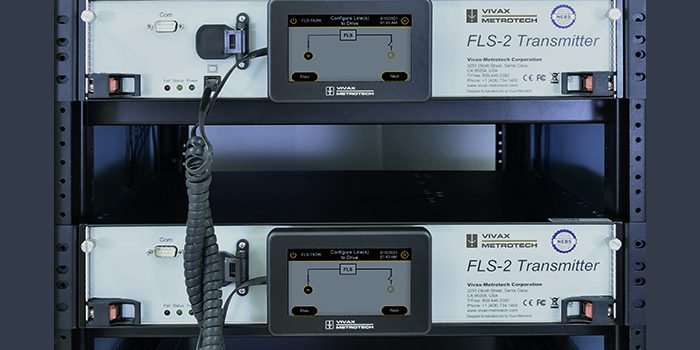
Locating Fiber Optic Cables
Fiber optic cables are a critical part of modern life carrying vast amounts of data to businesses, individual internet users, schools and emergency services.
The FLS-2 is a high-performance, long-distance fiber-optic cable locating and monitoring transmitter. The FLS-2 can be used for long-haul fiber lines and metropolitan loop networks as a central office or rack-mounted regen system. All the features of this 50-watt transmitter can be accessed remotely or locally with the hand-held touch screen.
The FLS-2 system consists of the FLS-2 Rack Mounter Transmitter with switching relays and hand-held Receivers (locators), which pick up the signal from the FLS-2 transmitter.

FLS-2 50-Watt Rack Mounted Transmitter

A few of the vLoc3 series compatible receivers
Concept
Marking the position of the cable reduces the danger of third-party damage.
The concept is that a permanently installed transmitter is positioned at a suitable regen station and switched remotely by its telephone interface, over the internet, or fixed telemetry control. When instructed, the FLS-2 lifts any local grounding and inputs a low-frequency current, typically 512Hz, into the sheath of the cable. This signal current travels along the cable and can be accurately located above ground using a suitable electromagnetic detector. When the signal is not required, the FLS-2 transmitter automatically switches the cable sheath back to the station ground minimizing danger from induced currents etc.
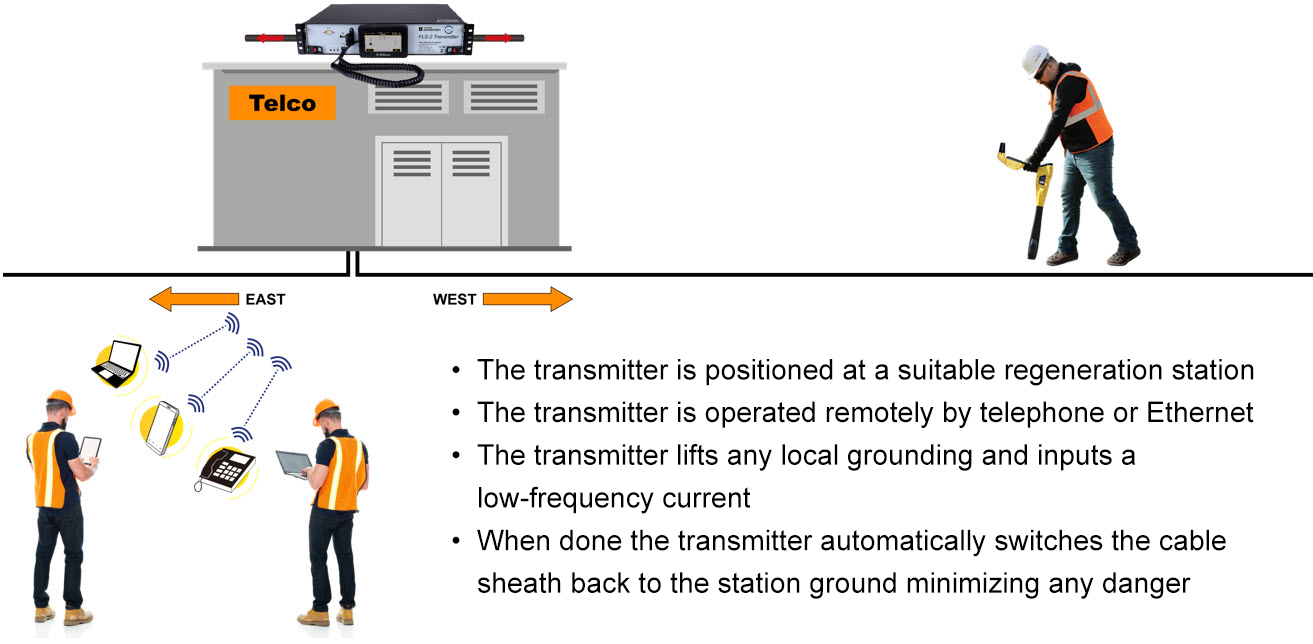
The FLS-2 Concept
The FLS-2 transmitter can transmit locate signals over many miles of cable, so installing FLS-2 transmitters at strategic locations throughout the network ensures good locate coverage.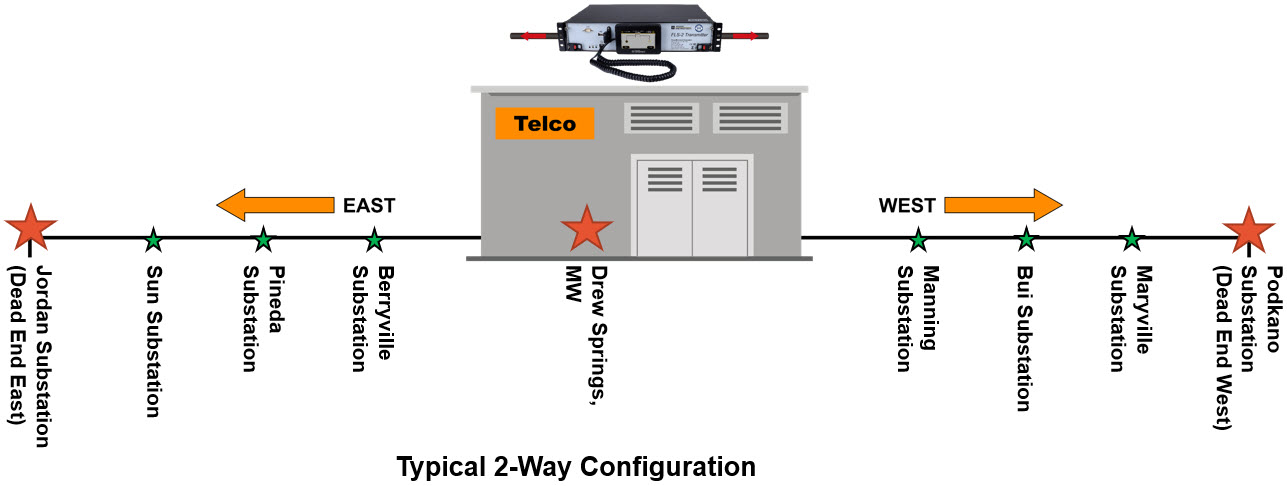
Advantages of the FLS-2 over traditional portable equipment
Traditionally a portable transmitter is used to apply a signal to the cable. This requires identifying an access point close to the area that has to be located. This usually requires access to the cable via a maintenance hole and a signal clamp to induce a signal at that point. The FLS-2 has many advantages over this method, as listed below.
>> Operator safety
When accessing a maintenance hole, subject the operator to unnecessary risks such as toxic gas, poisonous insects and general physical dangers. The FLS-2 negates these dangers by applying the signal at an established regen location removing the need to access a chamber.

>> Asset safety
Every time a cable is disturbed, there is the danger of causing damage to the cable. The FLS-2 system does not disturb installed cables.
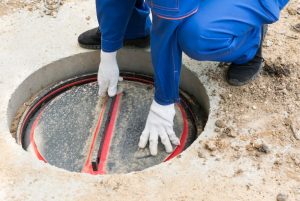
>> Operator error
It doesn’t matter how careful the operator is, and it does not change the fact that the operator may energize the wrong cable where there are multiple cables. This is not just with similar fiber cables; even fiber cables and mains cables can appear similar in a maintenance hole chamber situation.
>> Induction mode
When local access to the cable is impossible, the operator may be tempted to use the Induction mode. In this case, the transmitter is placed over the suspected location of the cable. A signal is radiated through the ground, energizing the cable with locate signal. The problem with this is that the signal is indiscriminate and will energize any cable or pipe nearby, leading to the wrong service being located. As the FLS-2 transmits the signal from a known application point, locating the wrong service is greatly reduced.
>> Efficient signal application
Locating a signal over long distances requires a high-power transmitter with a perfect electrical connection to the cable and the best possible grounding conditions.
The FLS-2 is a 50-watt transmitter powered from the stations -48VDC supply. This is five times the power of a typical high-power portable transmitter. Ground efficiency is calculated in Ohms, and a portable transmitter typically has a ground resistance at the ground stake of about 300Ohms. The FLS-2 uses the regen station ground, typically less than 1 Ohm, giving many hundreds.
>> Frequencies and Signal Direction (SD)
The applied signal current travels along the cable to another ground point, which travels back to the transmitter through the ground. At high frequencies, the signal will also leak onto adjacent cables and generate false signals fooling the operator into locating the incorrect cable. The FLS-2 applies a low frequency, typically 512Hz, which is low frequency, so the leaking or bleeding off is limited.
If a signal returns to the transmitter via an adjacent cable, the signal will be traveling in the opposite direction than the applied signal. The FLS-2 codes the signal with a signal direction (SD) signal, which tells the operator which direction the signal is traveling and, hence, the correct signal.
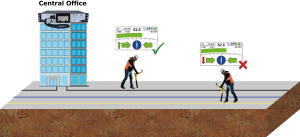
>> Speed of response
As soon as third-party activity commences near a fiber cable, it is in danger of being damaged. The faster the cable route is clearly and accurately marked out, the sooner that danger is minimized. The time to apply a quality signal to a cable using a portable transmitter can be hours, especially if the local access point is miles away. These are valuable lost hours.
Remote access and control of the unit save travel time to the transmitter site, and field technicians can now be dispatched directly to the locating area. Remote access can be achieved by a PC/laptop with a modem, via phone line-telephone network Ethernet access via IP address.
The cost of installing an FLS-2 system can be justified by improved Asset protection, Operator protection, and service reliability.